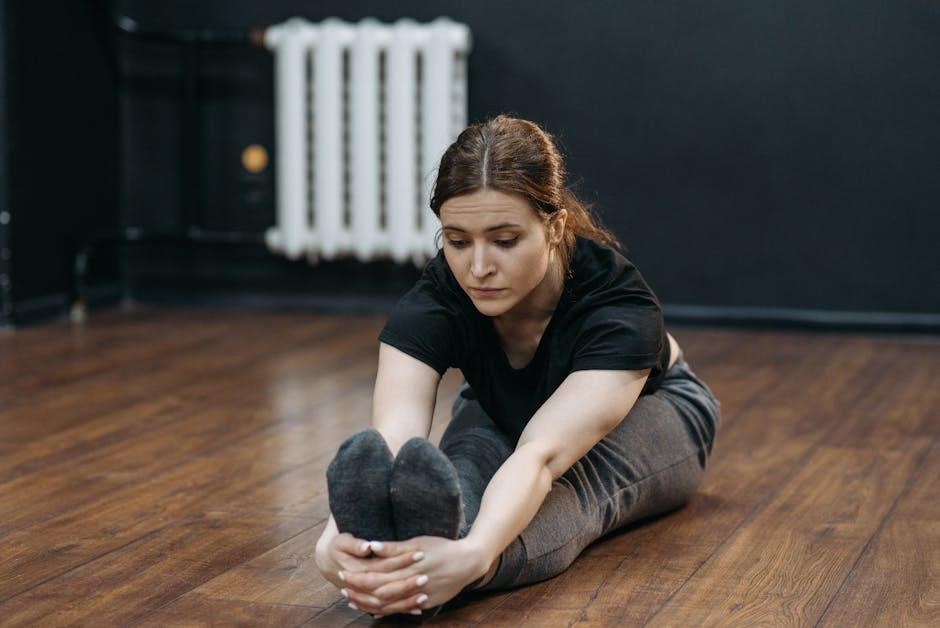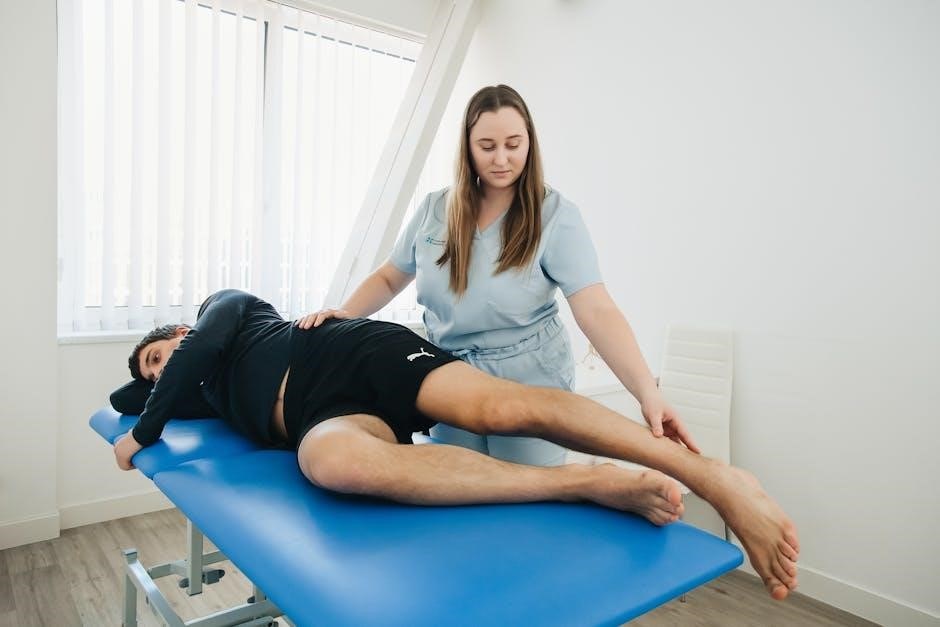Sacroiliac joint exercises are essential for improving stability, reducing pain, and enhancing mobility in the SI joint, which connects the pelvis and spine. These exercises combine strengthening and stretching techniques to promote joint health and alleviate discomfort, helping individuals maintain daily activities with greater ease and confidence.
1.1 Overview of the Sacroiliac Joint and Its Importance
The sacroiliac (SI) joint connects the sacrum and ilium bones, playing a vital role in absorbing shock and facilitating movement between the spine and pelvis. It is a key structure for stability and mobility, enabling activities like walking and twisting. Dysfunction in this joint can lead to lower back pain and discomfort, emphasizing its importance in maintaining proper spinal and pelvic alignment. Strengthening and stabilizing this joint is crucial for overall musculoskeletal health and preventing pain.
1.2 Benefits of Sacroiliac Joint Exercises
Engaging in sacroiliac joint exercises offers numerous benefits, including improved joint stability, reduced pain, and enhanced mobility. These exercises strengthen the surrounding muscles, such as the core and pelvic floor, which helps alleviate discomfort and prevent future dysfunction. Regular practice can also improve posture, reduce inflammation, and restore functional movement, enabling individuals to perform daily activities with greater ease and confidence. Consistency in these exercises is key to maintaining long-term joint health and overall well-being.
Understanding Sacroiliac Joint Pain
Sacroiliac joint pain arises from instability or inflammation in the joint connecting the pelvis and spine, often causing lower back and buttock discomfort that may radiate down the leg.
2.1 Common Causes of Sacroiliac Joint Pain
Sacroiliac joint pain often stems from misalignment or instability in the joint, which can occur due to muscle imbalances, poor posture, or repetitive strain. Inflammation from arthritis or overuse may also contribute. Trauma, such as falls, can disrupt the joint’s alignment, leading to discomfort. Additionally, weak core or pelvic muscles can strain the SI joint, causing pain and stiffness. Understanding these causes is crucial for effective treatment and exercise planning to restore joint stability and relieve symptoms.
2.2 Symptoms and Diagnosis of SI Joint Dysfunction
Symptoms of SI joint dysfunction include lower back pain, buttock pain, and discomfort radiating down the leg. Pain often worsens with activities like sitting, twisting, or standing. Diagnosis involves physical exams, movement assessments, and imaging tests to evaluate joint alignment and mobility. A healthcare professional may also use injection tests to confirm SI joint-related pain. Accurate diagnosis is critical for developing effective treatment plans to address dysfunction and alleviate symptoms effectively.

Strengthening Exercises for the Sacroiliac Joint
Strengthening exercises target the core and pelvic floor muscles to enhance SI joint stability. Techniques include planks, bridges, and leg raises, improving posture and reducing pain effectively.
3.1 Core Strengthening Exercises
Core strengthening exercises are vital for sacroiliac joint stability. Techniques like planks and bridges target the transverse abdominis muscle, improving posture and reducing SI joint strain. Regular practice enhances spinal alignment and joint support, minimizing discomfort and promoting overall lower back health.
3.2 Pelvic Floor Strengthening Techniques
Pelvic floor strengthening techniques, such as Kegel exercises, enhance SI joint stability by engaging the muscles that support the pelvis and lower back. These exercises improve posture, reduce pain, and promote better alignment. Regular practice strengthens the pelvic floor, which plays a crucial role in maintaining SI joint health and overall spinal stability. Proper form and consistent practice are essential for maximizing benefits and preventing discomfort.

Stretching Exercises for SI Joint Mobility
Stretching exercises for SI joint mobility focus on improving flexibility and reducing stiffness in the hip flexors, extensors, and pelvic muscles, enhancing joint movement and comfort.
4.1Hip Flexor and Extensor Stretches
- Lunge Stretch
- Targets hip flexors; kneel with one leg forward, lean forward slightly until a stretch is felt.
- Prone Stretch
- Lie on stomach, pull one leg toward chest, hold 20-30 seconds, repeat 2-3 times.
- Standing Stretch
- Stand, pull one leg behind, hold 20-30 seconds, repeat 2-3 times per side.
These stretches improve hip flexibility, reducing SI joint strain and promoting better mobility. Consistency is key for lasting relief.
4.2 Piriformis and Gluteal Stretches
Targeting the piriformis and gluteal muscles can alleviate SI joint discomfort. Lie on your back, cross the affected leg over the other thigh, and gently pull the unaffected knee toward your chest until a stretch is felt. For a seated stretch, cross the affected leg over the other thigh and lean forward slightly. Hold each stretch for 20-30 seconds, 2-3 times per side. These exercises reduce muscle tightness, improving joint mobility and reducing pain.
Stability and Balance Exercises

Stability and balance exercises enhance SI joint stability by strengthening core and pelvic muscles. Single-leg stances and plank variations improve posture, reduce wobbling, and promote joint alignment, preventing pain and instability while boosting overall lower back and pelvic region stability and control during daily activities and movements, ensuring better support for the sacroiliac joint and surrounding structures, which is crucial for long-term joint health and functionality, helping to maintain proper biomechanics and reduce the risk of further discomfort or injury.
5.1 Single-Leg Stance and Balance Training
Single-leg stances strengthen the muscles around the SI joint, improving balance and stability. Stand on one leg, keeping the other foot lifted or slightly touching the ground for support. Hold for 10-30 seconds, gradually increasing duration as you gain confidence. Switch legs and repeat 8-12 times. This exercise enhances pelvic alignment and core engagement, reducing SI joint instability. Perform near a wall for safety. Over time, progress by closing your eyes or using a soft surface to challenge balance further, promoting better joint stability and overall lower body strength while minimizing the risk of injury and improving posture and movement control.
5.2 Plank Variations for Core Stability
Plank variations are excellent for strengthening the core muscles that support the SI joint. Start with a forearm plank, engaging your abdominals and holding for 20-30 seconds. Gradually increase time as you build strength. Try straight-arm planks or side planks for variety. Modified planks on your knees are a great starting point if needed. These exercises improve spinal stability, reduce SI joint strain, and enhance overall posture. Perform 3 sets, progressing as your strength improves, to maintain a stable and pain-free lower back region while preventing future injuries and promoting better movement control and balance in daily activities.

Exercises to Avoid for SI Joint Health
Avoid high-impact exercises like running or repetitive heavy lifting, as they can strain the SI joint. Opt for low-impact alternatives to protect your joint health effectively always.
6.1 High-Impact Activities to Minimize
High-impact activities, such as running, jumping, or repetitive heavy lifting, can strain the sacroiliac joint, leading to instability or inflammation. These movements often involve sudden shocks or uneven stress, which can worsen SI joint dysfunction. Minimizing such activities is crucial to prevent further discomfort and promote healing; Instead, opt for low-impact exercises like swimming or cycling, which are gentler on the joints while still providing beneficial movement. Always consult a healthcare provider to tailor your exercise routine safely.
6.2 Positions and Movements That Exacerbate Pain
Certain positions and movements can worsen sacroiliac joint pain, such as prolonged sitting, heavy lifting, or sudden twists. Activities involving repetitive bending, uneven weight distribution, or excessive hip rotation can also strain the joint. Avoiding prolonged sitting in poor posture or repetitive movements that cause discomfort is essential to prevent further irritation. Adjusting daily activities and using supportive gear can help reduce strain on the SI joint.
Creating a Daily Routine for SI Joint Health
A daily routine incorporating strengthening, stretching, and stability exercises can significantly improve SI joint health. Consistency in performing core exercises, gentle stretches, and balanced activities helps maintain joint stability and reduces discomfort, promoting long-term well-being and mobility.
7.1 Sample Workout Plan for SI Joint Stability
A well-structured daily routine for SI joint stability includes a mix of strengthening, stretching, and balance exercises. Begin with core exercises like planks or bird-dog for 3 sets of 8-12 repetitions. Follow with pelvic floor activations and gentle stretches for hip flexors and piriformis muscles. Incorporate single-leg balances for 30 seconds on each leg. Finish with low-impact activities like swimming or cycling to maintain mobility without overloading the joint. Adjust intensity and duration based on individual comfort and progress.
7.2 Incorporating Exercises into Daily Life
Incorporating sacroiliac joint exercises into daily life is simple and effective. Start with short walks or gentle stretches during breaks. Use a standing desk to reduce prolonged sitting and promote better posture. Engage in mind-body practices like yoga or Pilates, which focus on core strength and flexibility. Replace high-impact activities with low-impact options like swimming or cycling. Consistency is key; even 10-15 minutes daily can significantly improve SI joint stability and overall well-being.
Consistency in performing sacroiliac joint exercises is crucial for long-term relief and stability. Regular practice enhances mobility, reduces pain, and improves overall joint health. Always consult a healthcare professional if pain persists or worsens to ensure proper treatment and avoid further complications.
8.1 The Importance of Consistency in Exercise
Consistency is key to achieving long-term benefits from sacroiliac joint exercises. Regular practice helps maintain joint stability, prevent dysfunction, and reduce pain over time. Incorporating exercises into your daily routine ensures sustained improvement in mobility and strength. Inconsistent efforts may lead to relapses, emphasizing the need for commitment. By prioritizing these exercises, individuals can effectively manage SI joint health and enhance their overall well-being with noticeable results over time.
8.2 When to Seek Professional Help
If sacroiliac joint pain persists despite consistent exercise, or if it worsens, seeking professional help is crucial. Consult a physical therapist or healthcare provider for personalized assessments and treatment plans. They can identify underlying issues and recommend advanced therapies or interventions. Persistent pain, limited mobility, or difficulty performing daily activities are signs that professional guidance is necessary to ensure proper healing and prevent further complications.

Leave a Reply